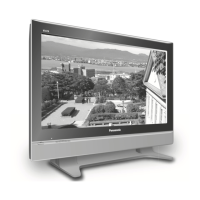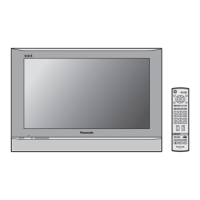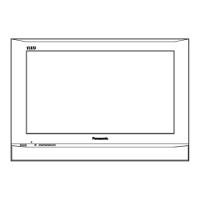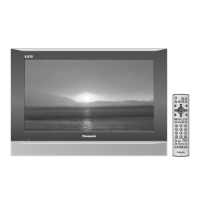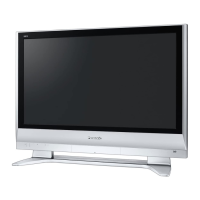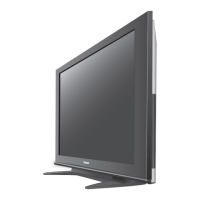
Do you have a question about the Panasonic TH-42PA30 and is the answer not in the manual?
General safety warnings for fire, shock, and electromagnetic fields.
Cautionary advice to prevent permanent image retention on the plasma screen.
Precautions for placing the TV and avoiding electromagnetic interference.
Guidelines for safe use, including ventilation and power cord handling.
Steps to take if issues like no picture/sound or smoke occur.
Instructions for cleaning the display panel and cabinet.
List of items provided with the television set.
Guides for installing ferrite cores and remote control batteries.
Steps for opening the front cover and terminal cover.
Methods for securing cables to the TV.
Connecting the TV to power and turning it on for the first time.
Introduction to features like C.A.T.S sensor.
Selecting the country and initiating the automatic channel tuning process.
Setting up Q-Link and resetting picture controls to default.
Description of the functions of various buttons on the remote control and front panel.
Explanation of how to use buttons to navigate on-screen menus.
Details about the on-screen help box and its purpose.
Selection of different screen settings like Dynamic, Normal, Cinema, and Auto.
Adjusting parameters like Contrast, Brightness, Colour, and Sharpness.
Modifying Bass, Treble, Balance, and Headphone Volume.
Utilizing features like MPX, Mode, and Ambience for enhanced sound.
Configuring Q-Link, AV outputs, and the off timer.
Adjusting text language, side panel display, and OSD language.
Managing power consumption and accessing tuning menus.
Customizing programme settings like adding, deleting, or editing channels.
Procedures for tuning channels automatically or manually.
Configuring colour systems, volume correction, and decoder inputs.
Procedures for managing programme channels in the list.
Manually tuning specific channels to their correct frequency.
Customizing channel names and restricting access.
Changing sound systems and copying programme information to a recorder.
Step-by-step guide for automatically tuning all available channels.
Choosing the correct country for optimal channel reception.
Performing manual channel tuning using the remote.
Manually tuning channels using the TV's physical buttons.
Requirements and methods for connecting Q-Link compatible devices.
Utilizing DIRECT TV RECORDING and auto power functions with recorders.
Exploring features like Image View On for enhanced device interaction.
Automatic adjustment of picture aspect ratio based on signal detection.
Manually choosing aspect ratios like 16:9, 14:9, Just, and 4:3.
Explaining how these aspect ratios display content.
Explaining how these aspect ratios display content.
Describing the picture scaling in Zoom1 and Zoom2.
Describing the picture scaling in Zoom3.
Viewing two different video sources simultaneously in separate windows.
Displaying two video sources side-by-side.
Viewing two video sources side-by-side in a specific arrangement.
Holding a static image or browsing through channels using freeze-frames.
Displaying the TV picture alongside teletext pages.
Choosing between Normal, Dynamic, Cinema, and Auto picture modes.
Fine-tuning picture parameters like contrast, brightness, and white balance.
Adjusting the horizontal and vertical position and size of the PC display.
Optimizing the PC signal for stable display.
Understanding image format compatibility and display limitations.
Guidelines for safely inserting, removing, and protecting memory cards.
Step-by-step instructions for SD and PC cards.
Identifying supported card types and navigating the card menu.
Modifying picture settings within the Photo View mode.
Configuring slide show intervals, sequence, and card selection.
Switching between viewing multiple thumbnails and a single enlarged image.
Setting up and viewing images as an automated slide show.
Operating VCR/DVD functions like Standby, Play, and Stop.
Using skip, pause, and record functions for VCR/DVD equipment.
Understanding TOP and List modes and how to select pages.
Utilizing features like Reveal, List Store, and Hold for teletext viewing.
Storing favourite teletext pages and managing updates and news flashes.
Navigating through teletext pages that are divided into multiple sub-pages.
Alternative ways to select teletext sub-pages.
Returning to the main teletext index page.
Choosing the active input source (AV1, AV2, etc.) using the TV/AV button.
Connecting headphones and audio/video devices to the AV3 terminal.
Connecting the TV's audio output to external amplifiers or speakers.
Wiring diagrams and compatibility for AV1, AV2, and AV4 Scart terminals.
Connecting devices via component video inputs.
Instructions for connecting a computer to the TV's PC input.
Details of the D-sub 15P connector pin assignments for PC input.
Troubleshooting guides for common visual and audio issues.
Addressing issues related to the plasma screen, such as after-images.
Pinout information for Scart terminals AV1 and AV2.
Pinout information for Scart terminals AV3 and AV4.
Table listing compatible horizontal and vertical frequencies for PC input.
Technical details on power consumption, panel size, and audio output.
Information on supported signals, input/output terminals, and supplied accessories.
Physical dimensions and weight of the television.

